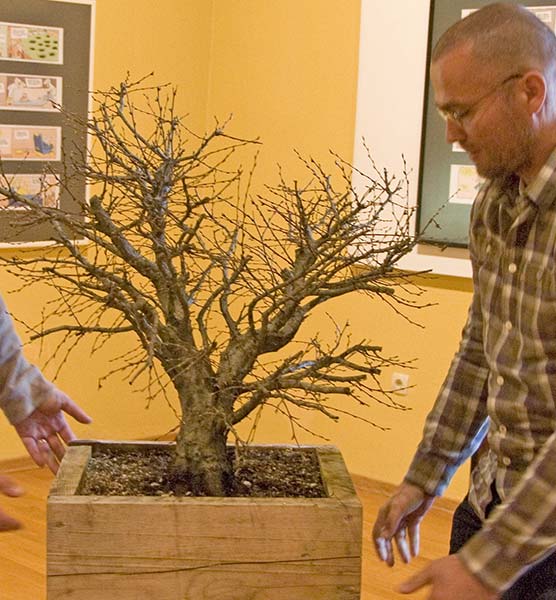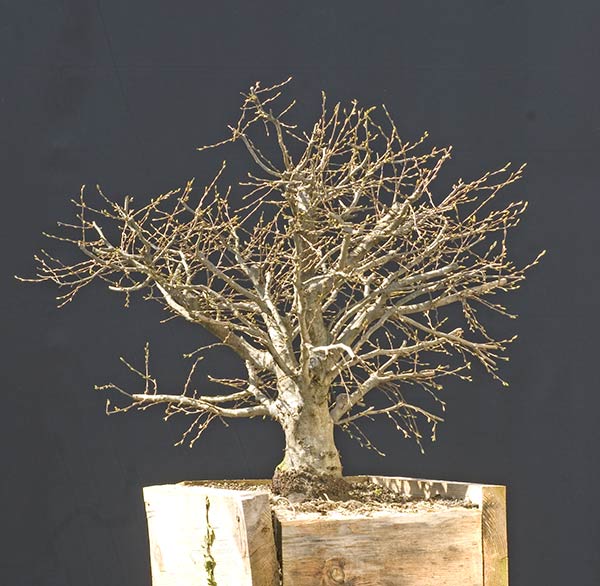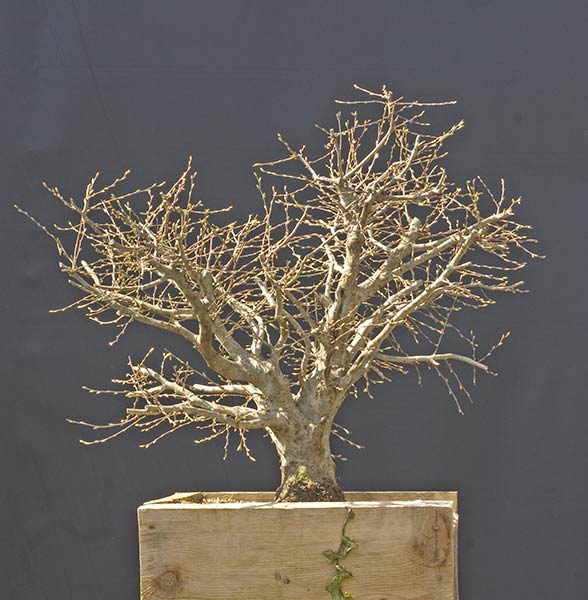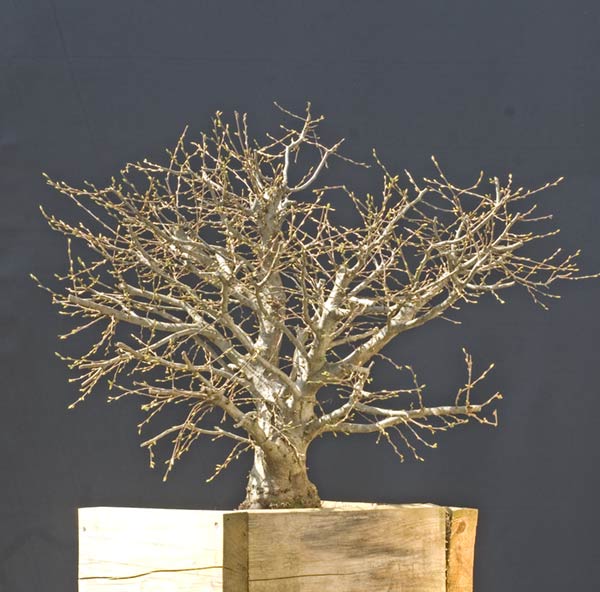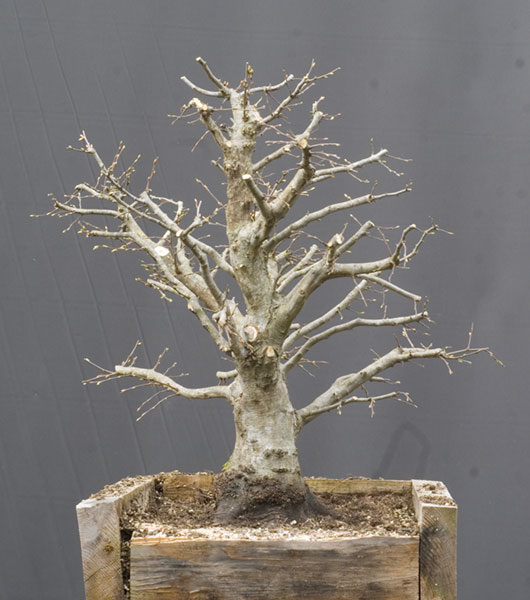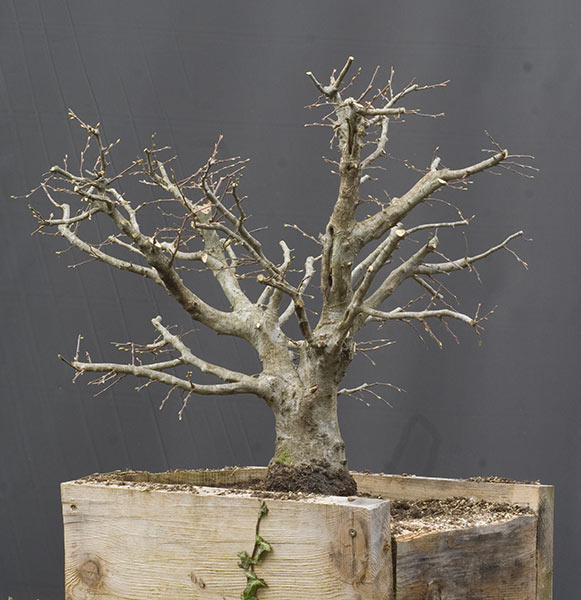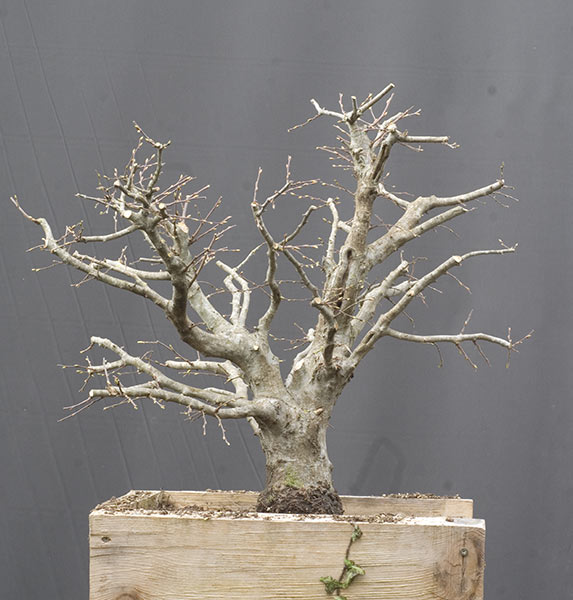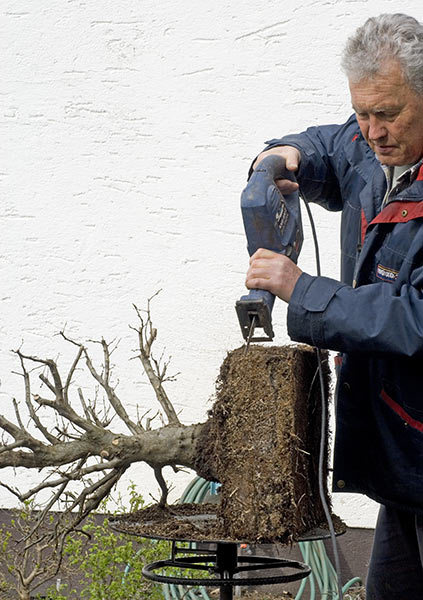How about styling something like this?
+15
Nick K
Vance Wood
Marko
Fore
-Daniel-
Jake16
Jkd2572
Rick36
DangerousBry
Joao Santos
Ed van der Reek
Dirk Hoorelbeke
Frojo
Mitch Thomas
Walter Pall
19 posters
Page 1 of 2
Page 1 of 2 • 1, 2 
 How about styling something like this?
How about styling something like this?
This tree grows rather close to my home. How about using this European oak as and example for bonsai. I believe that it should be possible to come close. Is this too much of a wild tree and too little of a bonsai?
Ten years ago the answer was " this is a very nice tree but it is not good as an image for a bonsai" Why? "Because it does not look like a bonsai and because it is not possible anyway to get this sort of detail."
What is the answer today?
How about doing some virtual potting?
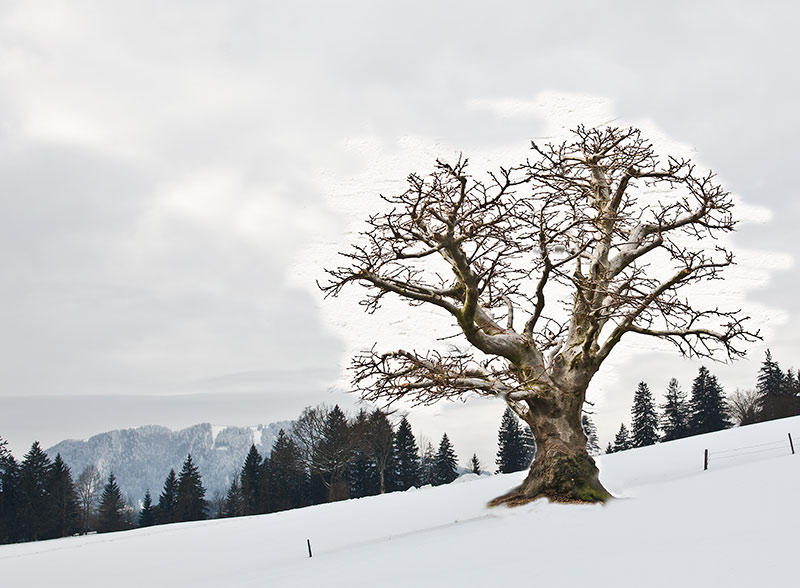
Ten years ago the answer was " this is a very nice tree but it is not good as an image for a bonsai" Why? "Because it does not look like a bonsai and because it is not possible anyway to get this sort of detail."
What is the answer today?
How about doing some virtual potting?


Walter Pall- Member
 Style
Style
Hi Walter
We have been bottle fed a constant diet of triangle shaped cookie cutter styles. Like all personal taste that comes and goes we are attracted to things that we haven't seen before. Now many teachers advocate that we imulate what we observe in nature. "Make your Tree look like a Tree" is the genera. In this teaching we have the need to classify our designs. IMHO this is what's happening now in the art of bonsai. IE the pernief style from Africa, flat top style from the US, ect, ect, recent styles I have seen here in the US is the "southern live oak style" that represents the trees we use as models for our bonsai.
So my answer to your question is it is a style as well as many others that need to be explored as our art form expands and matures.
This phenomenon has happened before in bonsai many times producing styles that stray fom the norm, literati/ bunjin is prob the most recognized.
I'm sure we will get many responses to the contray, this is our nature but the debate is healthy!
Mitchell Thomas
We have been bottle fed a constant diet of triangle shaped cookie cutter styles. Like all personal taste that comes and goes we are attracted to things that we haven't seen before. Now many teachers advocate that we imulate what we observe in nature. "Make your Tree look like a Tree" is the genera. In this teaching we have the need to classify our designs. IMHO this is what's happening now in the art of bonsai. IE the pernief style from Africa, flat top style from the US, ect, ect, recent styles I have seen here in the US is the "southern live oak style" that represents the trees we use as models for our bonsai.
So my answer to your question is it is a style as well as many others that need to be explored as our art form expands and matures.
This phenomenon has happened before in bonsai many times producing styles that stray fom the norm, literati/ bunjin is prob the most recognized.
I'm sure we will get many responses to the contray, this is our nature but the debate is healthy!
Mitchell Thomas
Mitch Thomas- Member
 Re: How about styling something like this?
Re: How about styling something like this?
IMHO this is one of the styles that is captivating... And can hold your gaze for a little longer. Certainly in its winter image.
Thanks
Bryan
Thanks
Bryan

DangerousBry- Member
 Re: How about styling something like this?
Re: How about styling something like this?
Never thought of photo shopping my trees into a real landscape. What a brilliant idea. Thanks.
Jkd2572- Member
 Re: How about styling something like this?
Re: How about styling something like this?
hehe Walter, you always have a certain way of making your point/statement, funny, witty, ironic, evocative or provocative. Thats nice, it feeds my bonsai-soul and challenges my brain :-).
My personal opinion is, why the hell should i feel the need to apply japanase rules when trying to make miniature trees out of our endemic species here (belgium). I never got that, and will never get it. So ok, we stole some ideas from the japanese, so what? The japanese, chinese, taiwanese... themselves are masters at copying ideas of others and give it their own stamp.
But i'm not against anyone or any bonsai that is styled according to traditional japanese rules. I'm just talking about the right (and need) to let the art spread and therefore evolve, adapt...
My personal opinion is, why the hell should i feel the need to apply japanase rules when trying to make miniature trees out of our endemic species here (belgium). I never got that, and will never get it. So ok, we stole some ideas from the japanese, so what? The japanese, chinese, taiwanese... themselves are masters at copying ideas of others and give it their own stamp.
But i'm not against anyone or any bonsai that is styled according to traditional japanese rules. I'm just talking about the right (and need) to let the art spread and therefore evolve, adapt...
Guest- Guest
 Re: How about styling something like this?
Re: How about styling something like this?
Thank goodness some one finally posted that  I also came to that conclusion and am just astounded that this is a bonsai. Fantastic tree Mr. Pall I would give a leg for a tree like that.
I also came to that conclusion and am just astounded that this is a bonsai. Fantastic tree Mr. Pall I would give a leg for a tree like that.

Jake16- Member
 Re: How about styling something like this?
Re: How about styling something like this?
My thoughts of bonsai is "look at nature and try to copy it." This is my bonsai, my woods where I treking, my mountains I observe. 
Best regards mister Pall

Best regards mister Pall
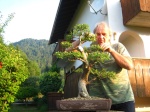
-Daniel-- Member
 Re: How about styling something like this?
Re: How about styling something like this?
Walter,
To answer your question; yes the trend nowadays is leaning towards styles that are more commonly found in nature and advocated by a lot more bonsai teachers than before. For example, in last year's Midwest Show critique Ryan Neil was explaining the concept of deciduous branches of a heavy oak initially rising up and then with the shear mass of it drooping down. In some extreme cases the branch will droop to the ground and then rise back from the ground. In Ryan's opinion if we can capture that in bonsai, then that would be awesome. [This critique was on a beech bonsai where the branches were simply shaped down without the initial rise].
Having said that, it is important for a novice to understand, implement and appreciate the so-called rules set by Japanese in order to advance to styles that you are advocating. Even in Japan there are some masters who have certain show trees in their collections that don't adhere to these rules. I know that Suzuki and Fujikawa have such trees.
To answer your question; yes the trend nowadays is leaning towards styles that are more commonly found in nature and advocated by a lot more bonsai teachers than before. For example, in last year's Midwest Show critique Ryan Neil was explaining the concept of deciduous branches of a heavy oak initially rising up and then with the shear mass of it drooping down. In some extreme cases the branch will droop to the ground and then rise back from the ground. In Ryan's opinion if we can capture that in bonsai, then that would be awesome. [This critique was on a beech bonsai where the branches were simply shaped down without the initial rise].
Having said that, it is important for a novice to understand, implement and appreciate the so-called rules set by Japanese in order to advance to styles that you are advocating. Even in Japan there are some masters who have certain show trees in their collections that don't adhere to these rules. I know that Suzuki and Fujikawa have such trees.
Guest- Guest
 Re: How about styling something like this?
Re: How about styling something like this?
Hehehe
You got me! No wonder I really liked your first image! I love your naturalistic style and try to employ it myself! I would love to attend your school, its# 3 on my bucket list!
Mitch
You got me! No wonder I really liked your first image! I love your naturalistic style and try to employ it myself! I would love to attend your school, its# 3 on my bucket list!
Mitch
Mitch Thomas- Member
 Re: How about styling something like this?
Re: How about styling something like this?
A bit more effort on photo shoping the cloud and you would of had me, BUT go back and look at the tree in its natural surroundings. Is it really natural? Chop marks still exist, right angles from chop mark into tertiary branching effect flow, lack of taper between secondary and tertiary branching etc. If the story behind this tree was that overhead powerlines meant that local authorities had to intervene and constrain the tree then yes it may be a realistisic example. Look at Japanese specimen decidious trees cultivated over generations, there are none more natural.
Marko- Member
 Re: How about styling something like this?
Re: How about styling something like this?
Sorry, I had to interrupt posting the history of this tree. I had to get onto the road to Noelanders Trophy, people were waiting for me. I will continue on Monday.

Walter Pall- Member
 Re: How about styling something like this?
Re: How about styling something like this?
Someone who would actually pillory this image should be pilloried themselves. The image is beautiful and belongs in a bonsai pot if it is possible to create this image; and I believe it is. Just because you cannot find a Japanese style that fits, it is the fault of the Japanese for not noticing it sooner. This tree is beautiful and a joy to behold.
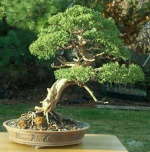
Vance Wood- Member
 Re: How about styling something like this?
Re: How about styling something like this?
Hi All,
My 2 cents worth.
I believe that in any art form style can be very subjective. Just because I see something different to you doesn't make it wrong. No great artist of any medium has ever just stuck to one style ( maybe a few exceptions but you get what I meen ) style is an evolution of you as you age and have different experiences and experience different emotions. I would have styled Walters tree differently perhaps, but then again if a lovely Pavel type pine was sitting right next to it then I would have collected that instead & my eye would have been drawn to "The Pine Style" first in any display format ( I am a young guy and the dominant masculine style will draw my attention first). So to conclude Beauty Is In The Eye Of The Beholder. It's that simple IMHO.
Nick
P.S. Walter great tree. Great progression.
My 2 cents worth.
I believe that in any art form style can be very subjective. Just because I see something different to you doesn't make it wrong. No great artist of any medium has ever just stuck to one style ( maybe a few exceptions but you get what I meen ) style is an evolution of you as you age and have different experiences and experience different emotions. I would have styled Walters tree differently perhaps, but then again if a lovely Pavel type pine was sitting right next to it then I would have collected that instead & my eye would have been drawn to "The Pine Style" first in any display format ( I am a young guy and the dominant masculine style will draw my attention first). So to conclude Beauty Is In The Eye Of The Beholder. It's that simple IMHO.
Nick
P.S. Walter great tree. Great progression.

Nick K- Member
 Re: How about styling something like this?
Re: How about styling something like this?
Wonderful to see Walter wielding the electric saw on the compacted roots. I started doing this a few years ago but never admitted to it !!
geepee- Member
 Re: How about styling something like this?
Re: How about styling something like this?
geepee wrote:Wonderful to see Walter wielding the electric saw on the compacted roots. I started doing this a few years ago but never admitted to it !!
I've been using this technique for twenty years. It is far superior than using a root hook which tends to tear and break roots you may not have intended to damage. I have found that at the next repotting you can start going after the roots you left undisturbed previously.

Vance Wood- Member
 Re: How about styling something like this?
Re: How about styling something like this?
Vance Wood wrote:Someone who would actually pillory this image should be pilloried themselves. ...............
I call that a very unnecessary remark and slightly intimidating.
This is a discussion forum and not a place of 'worship' so I don't see why differing opinions should not be welcome.

charlesryder- Member
Page 1 of 2 • 1, 2 
Page 1 of 2
Permissions in this forum:
You cannot reply to topics in this forum









